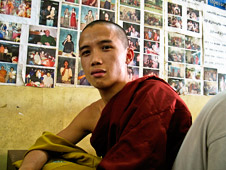
Breathe in a man. Breathe out a man. The old Buddhist monk says this in the empty monastery after most of his colleagues and students have disappeared. Some are in prison. The others have fled to the countryside. At this moment there are military forces spread throughout the capital setting up roadblocks, filtering for dissidents and young Buddhist monks who marched in the streets in the hundreds of thousands. The authorities are taking their time. Everyone looks sick and malnourished unless they are part of the regime. Those who work for the regime wear a layer of fat and round faces.
The monastery is quiet because it is empty. We are sitting on the polished floor during the cool season after the monsoon, the old monk is looking at me. When I close my eyes and breathe in I cannot hear the helicopters scream on their pad in Fallujah. When I breathe out I see the place where my friend Ko Kyaw Zaw lived. This is the monastery where he studied before the uprising and where told me two years ago about meditation how would calm the mind. Yes, you can have freedom, he said. Now I breathe in the cool, still air of the monastery sitting on the polished wood in the meditation hall trying to find him. Breathe out a man, the old monk tells me. Do this now. When the practice is over I tell him why I am here.
I bring up a picture of Ko Kyaw standing in front of a gold pagoda smiling directly at the camera and the old monk looks at it and nods carefully. You will not find him, the old monk says. You cannot help him now. After the uprisings in September the military came to the monasteries at night in trucks to make their arrests. Soldiers and intelligence men attacked the unarmed men out of view of the cameras. Later, the bodies of young men were found dumped in rivers. In a Buddhist society, this crime has other meanings in addition to the usual sanctions against murder. The attackers have become demons. The community of monks, the Sangha, has been scattered.
Ko Kyaw was now missing in the days after the uprising and it was possible that he was rounded up and taken to one of the gulags which the regime maintains. It was possible that he was dead. When I open my eyes, the old monk asks me if I would like to know my fortune and I agree. The teacher is nearly eighty years old and he is not afraid of the authorities. He takes my notebook and writes a collection of symbols and then looks up at me and says, You will be arrested. There will be problems with military intelligence and they will come for you.![]()
 LEAD IMAGE: Rangoon, Myanmar, 2005. A Buddhist monk in an introductory English language class. Monks from his monastery would go on to participate in massive non-violent uprisings across the country in September 2007 which would later be called the Saffron revolution. It was brutally suppressed by the military government, and resentment persists. Thousands are still missing.
LEAD IMAGE: Rangoon, Myanmar, 2005. A Buddhist monk in an introductory English language class. Monks from his monastery would go on to participate in massive non-violent uprisings across the country in September 2007 which would later be called the Saffron revolution. It was brutally suppressed by the military government, and resentment persists. Thousands are still missing.Photo: Matthew Robertson
© Phillip Robertson, 2009-2020.
